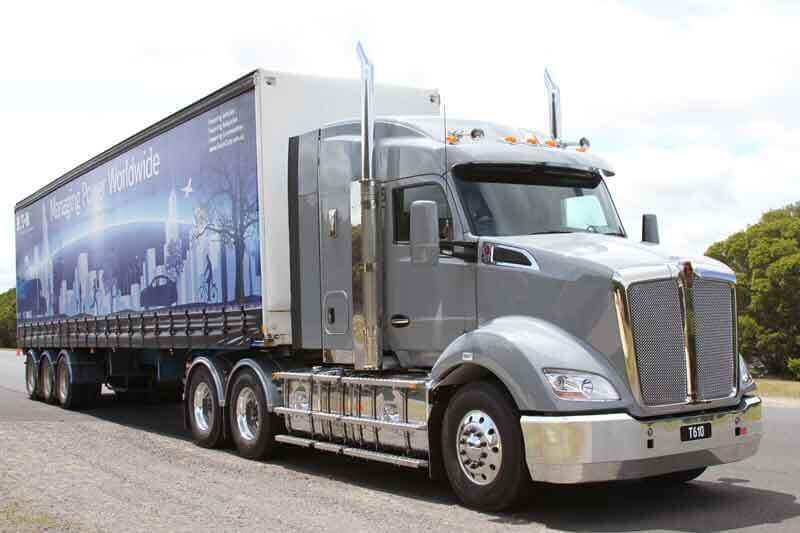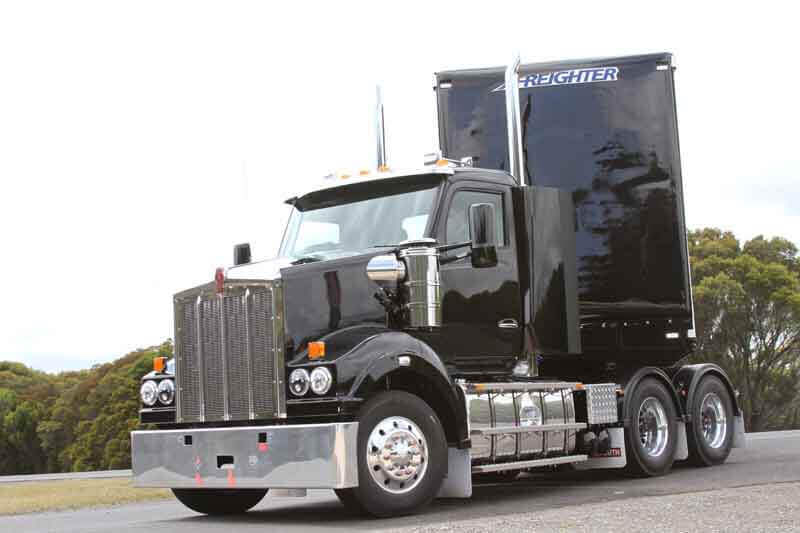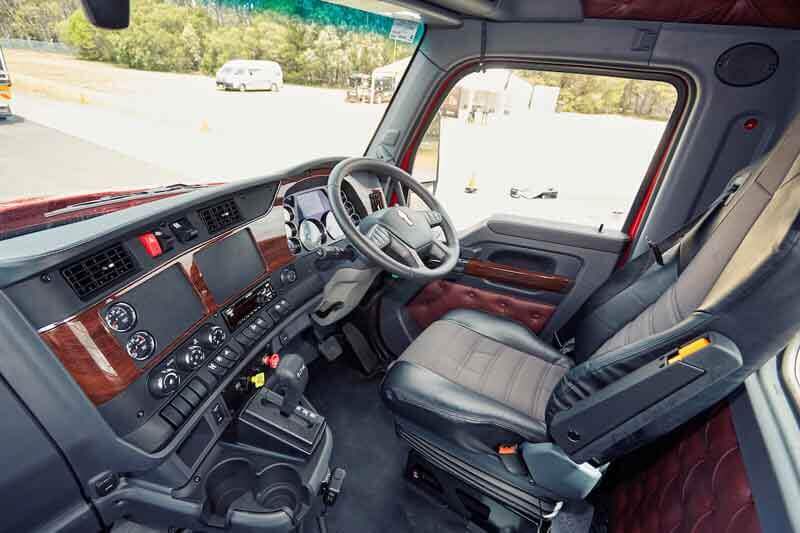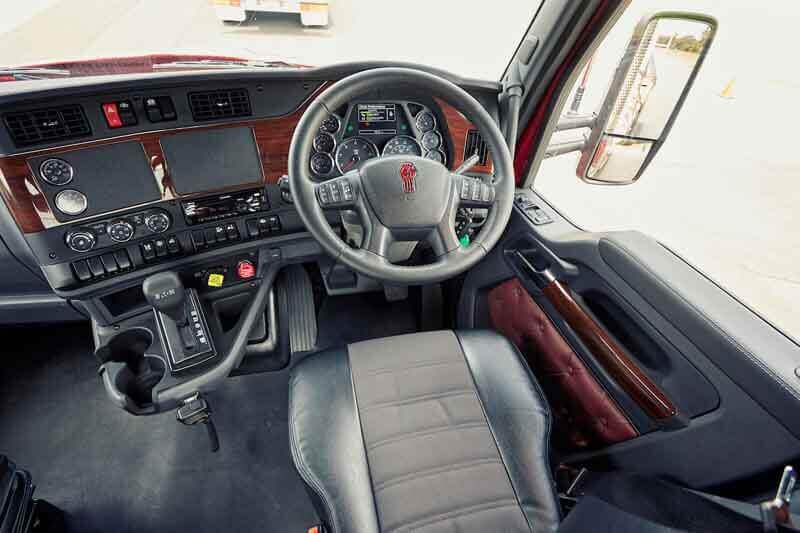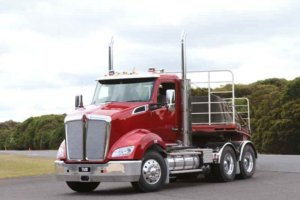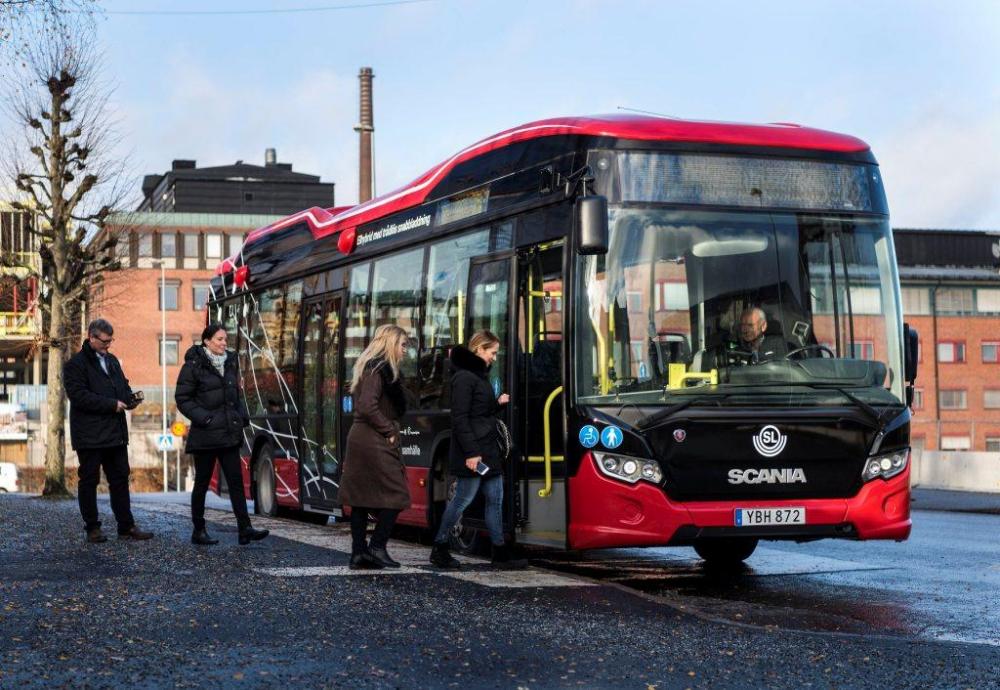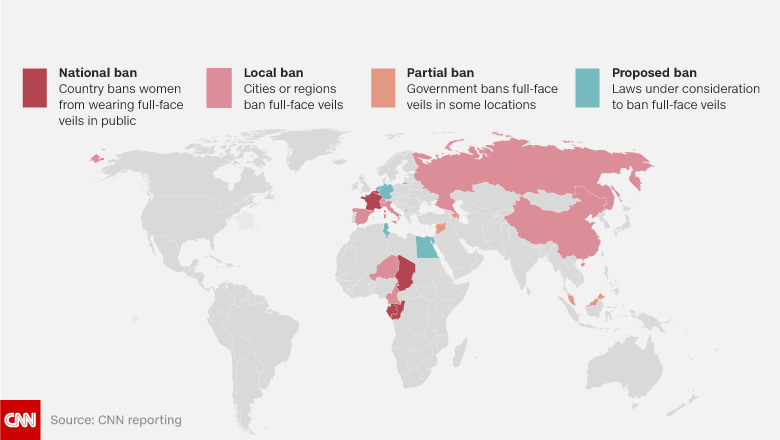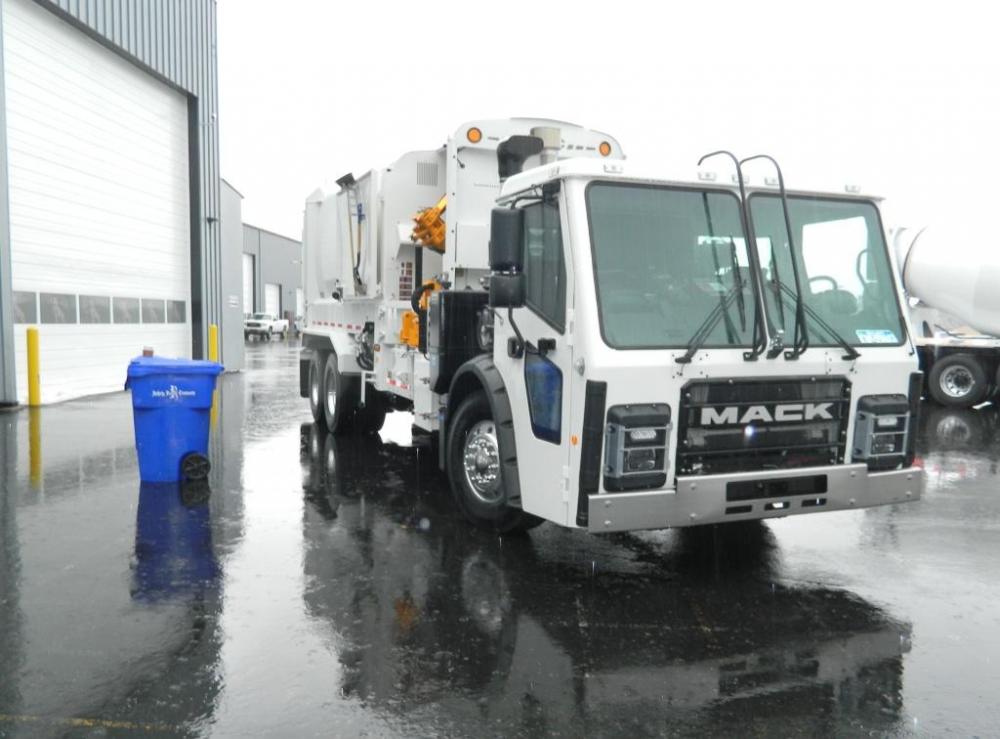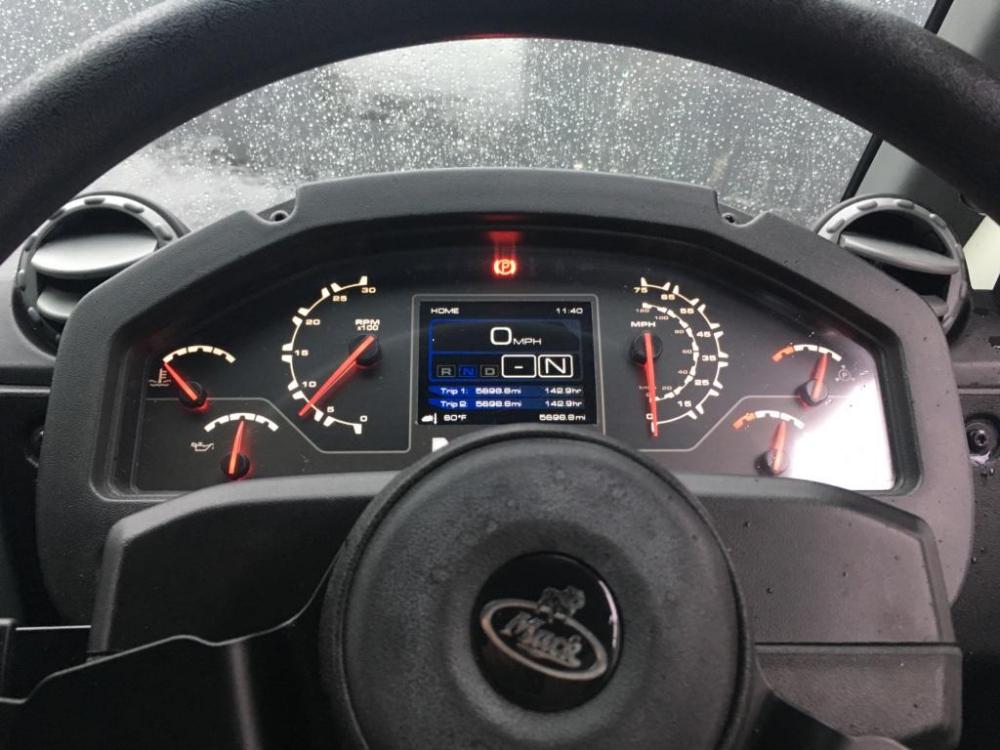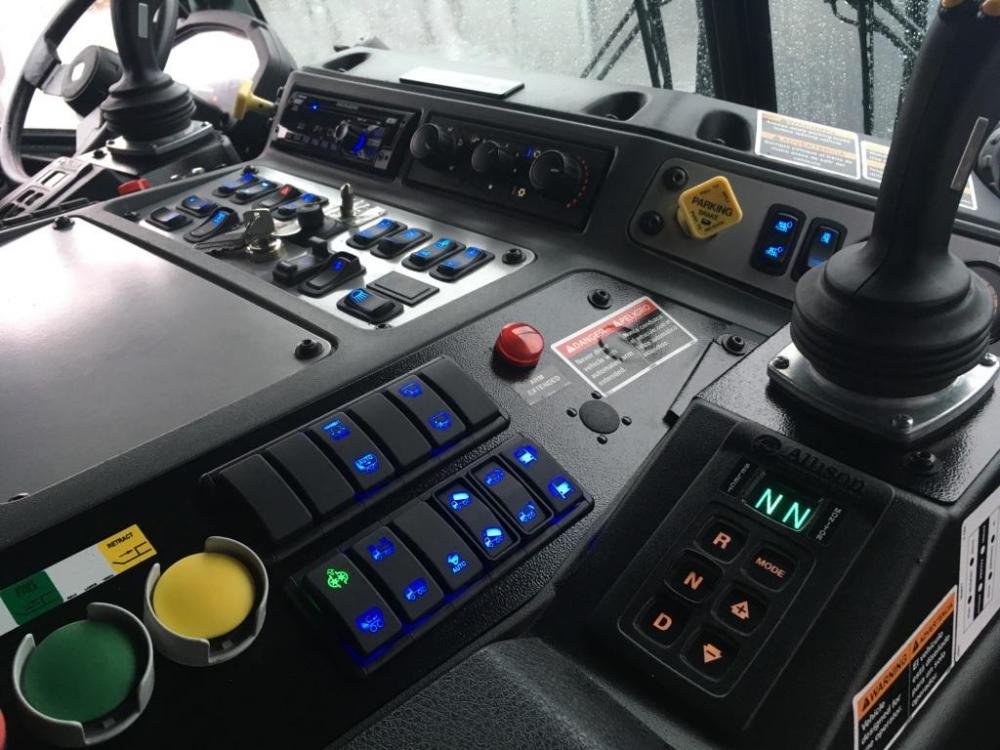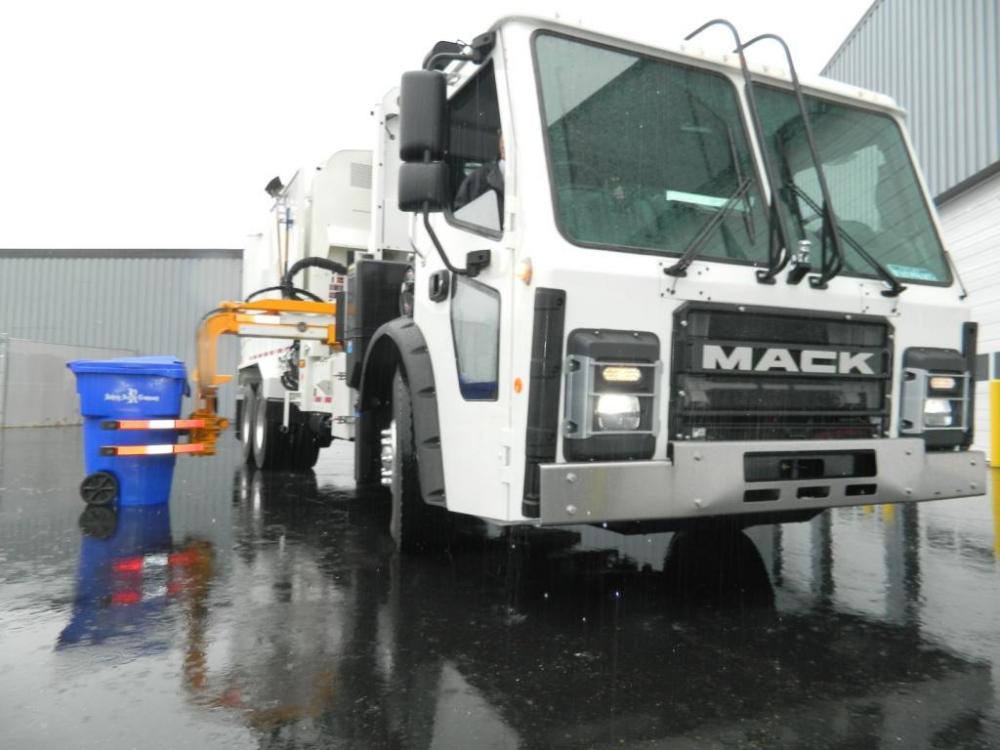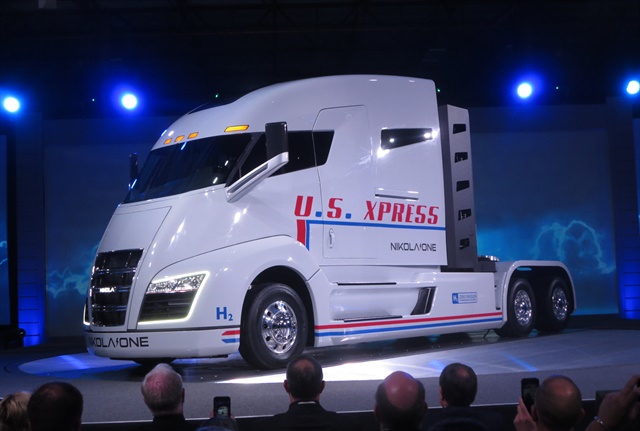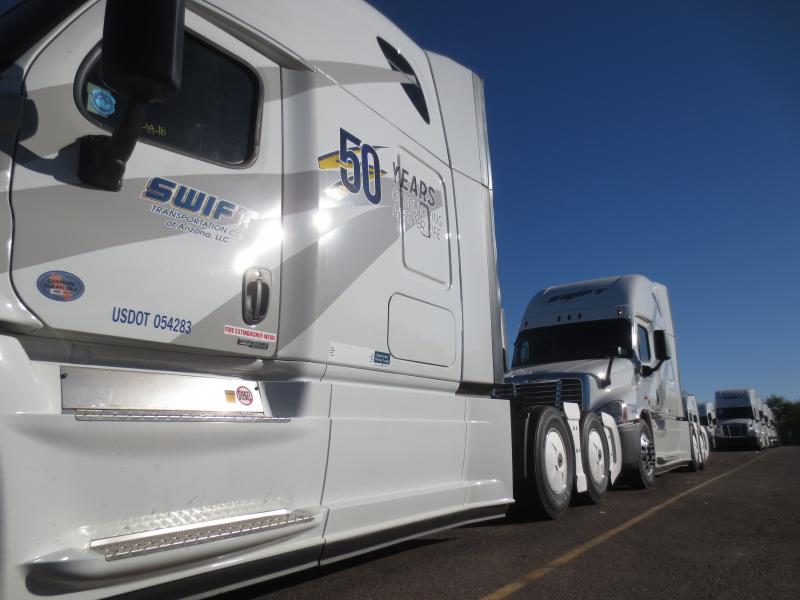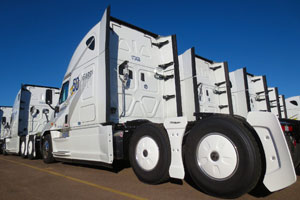
kscarbel2
Moderator-
Posts
18,905 -
Joined
-
Days Won
114
Content Type
Profiles
Forums
Gallery
Events
Blogs
BMT Wiki
Collections
Store
Everything posted by kscarbel2
-
WIDE APPEAL Power Torque Magazine / December 2016 Dave Whyte and Chris Mullett find the Kenworth T610 brings in the long-awaited appeal of a wide cab for conventional operators It’s not exactly been the best kept secret in Australian trucking, but when production kicks off finally in February and the wide cab versions start entering fleets there are going to be a lot of extremely satisfied drivers out on the road. Eagle-eyed readers of PowerTorque have spotted the five trucks seeded into major fleets as they’ve been racking up the kilometres under the most extensive product testing Kenworth has completed in our market to date. One such example used on linehaul with driver changes is currently covering 14000 km each week. But there’s much more to the development of the T610 than just producing five prime movers and running them up and down the highway. Brad May, director of sales and marketing for PACCAR Australia, gave PowerTorque an exclusive insight into the T610 development programme that started back in 2012, at the same time that PACCAR in the United States showcased the Kenworth T680 and Peterbilt 579 at the Mid-America Truck Show. “The T610 is the result of a $400 million investment programme that has been built around the decision to increase the width of the cab from the previous 1.83 metres measured between the B-pillars to 2.1 metres,” said Brad. “It may sound a simple idea, but the development programme to substantiate the increase in width also resulted in a new design of floor plan and a totally new method of assembling the cab structure during manufacturing. The work also included a wide range of changes to the interior design and dashboard layout that has produced a more modern visual appearance and improved ergonomics,” he added. The initial development work was a combined programme between the two PACCAR brands of Kenworth and Peterbilt in the United States, in conjunction with the R&D team at Bayswater in Victoria. The Kenworth development team concentrated on the bonnet and cab changes, while Peterbilt developed the interior dashboard layout and trim requirements. Building a larger cab meant changing the construction method from a reliance on Huck bolts to using Henrob self-piercing rivets for the alloy framed and sheeted cab. The roof for the sleeper versions is manufactured in composite material. The larger width of 2.1 m has provided an increase in interior space in many areas of up to 30 percent, but has been achieved with virtually no additional weight penalty, with the new cab tipping the scales at just a 20 kg difference. The bumper to back-of-cab (BBC) measurement of the T610 has moved from the 116-inch dimension of the T409 it replaces, to 112 inches, and, with noise intrusion significantly reduced, there’s also additional strength in the firewall that is now 60 percent thicker at 4.0 mm compared to the T409 at 2.4 mm. Drivers will appreciate the additional space between the seats when moving around the cab interior and also how the forward vision has been improved. The traditional West Coast style of mirrors has been replaced by aerodynamic power adjustable mirror heads mounted on extended arms from the A-pillar. This new location enables forward vision over the top of the mirror housing, and between the mirror housing and the A-pillar, removing previous blind spots. The injection moulded dashboard is now much more car-like in appearance and features digital display screens showing driver information and engine data such as fuel economy and performance. With a completely new floor design there’s now much more room in the footwell around the pedals, with extra space for the driver’s left footrest. A lot of development work has also taken place in the redesign of the HVAC (heating, ventilation and air-conditioning) system, which is now a full climate-control unit. In past designs, where a right-hand-drive version has been the result of modifications to an original left-hand-drive design, there have always been issues occurring through routing the steering column past components such as turbochargers. Often the solution has been to incorporate a series of universal joints. Because of the close collaboration of the three design teams between America and Australia, it was possible to create a straight path for the steering column, right through from the wheel to the steering box. This results in probably the best steering precision yet achieved for an on-highway truck of this category. The electrical system retains the normal US choice of 12 volts, but is now based on a multiplex system, with the new cab frame constructed in the US and shipped direct to the Bayswater factory in Victoria. The cooling system has also come in for close attention, with the radiator on the T610 now based on aluminium cores, replacing the previous copper and brass construction. The durability of the new designs has been verified by extensive finite element analysis and then further confirmed by physical shakedown testing on continuous activity rigs that reproduced highly destructive road conditions. The shake-down testing programmes were repeated three times more than any previous test programme in order to validate the durability by simulating over 10 million kilometres of real-time experience. As well as the single-cab version, the T609 is available as a sleeper cab SAR with a set forward front axle. This features the traditional Aerodyne style sleeper but without the roof mounted windows that featured in previous versions. The bed size has been maintained at 860 mm, the same spec as used in the previous 36-inch sleeper design to maintain compatibility for 19 m and 26 m B-double application. “We looked at how to improve headroom and spaciousness inside the cab and the input we had into the final designs enabled us to move the high roof slope forwards in the roof line,” said Brad. “Mike Dozier, Kenworth Australia’s chief executive at the time of the T610 development programme, came from a product background with Peterbilt. Being tall himself, he was a strong supporter of ensuring sufficient headroom to promote the feeling of interior spaciousness with excellent walk-around access. “This attention to visibility for tall drivers also resulted in the window line of the doors being styled to provide clear vision, without having to stoop to improve line of sight. “The doors themselves have triple seals to prevent noise and dust intrusion, and no longer have to carry the mirror mounts, which, as mentioned previously, are now fixed to the A-pillar framing. Conventional hinges now replace the older-style piano hinges, providing a more positive and refined door closure,” added Brad. The T610 is the culmination of many years of extensive product development and cooperation between Paccar in Australia and the United States. Although currently confined to one model in two configurations, there’s little doubt that over the next couple of years we will be seeing the innovation of the T610 influencing other models throughout the Kenworth Australia product range. .
-
The Gazette Xtra / December 7, 2016 Larry Brown descended the steps of his Chevrolet oil tank truck in two small leaps and disappeared around the back, past the red-and-blue lettering on his truck that reads "Brown Oil Co." Brown unreeled a red fuel hose and hauled it across the snow, through the yard of a weathered farmhouse in the town of Avon. He linked the hose to a pipe on the side of the house and pumped red-dyed fuel oil into a holding tank in the basement. The whole time, Brown whistled a tune. It seemed less like a song and more a physical function—the way a power generator kicks on and off whenever it needs to. Brown has run Brown Oil in Janesville, Wisconsin, since 1986. And he has hauled diesel, gasoline and fuel oil to customers for 50 years this December—ever since he was 20 years old. Brown now is 70, yet his age doesn't quite show. He still delivers oil and fuel oil in one of his own trucks, even though he employs drivers who are much younger than he is. Brown Oil is one of only a few remaining independent oil haulers, and Brown has remained in business by continuing to find new customers outside the dwindling fuel oil home heating market. For years, home heating has been become more and more dominated by natural gas and LP gas, a trend that has put dozens of other oil haulers out of business. Brown Oil continues, and it continues to change, although Brown doesn't acknowledge he has changed much. He still runs dozens of deliveries a week in his tank truck, long after most in the business would leave the work to younger men. “I don't have a hobby, and I've never fished or hunted a lot,” Brown said. “This job is me, and I don't feel like closing up shop and dying. This job is my alternative, I guess.” In his 30 years running Brown Oil, Brown has marketed his services to an ever-broadening clientele, including road construction crews, quarry pits and local marinas, all while holding onto a shrinking base of fuel oil home heating customers. This week, Brown delivered fuel oil to several homes and farms throughout the county alongside commercial deliveries that included a semitrailer truck service garage on Bell Street in Janesville. One day this week, he delivered 250 gallons of kerosene to a Beloit business. Brown boiled down the 50 million gallons of oil he estimates he has delivered to customers over five decades, summing up his concept of business diversification: “There's always different things going on. A chance for new customers all the time. You've always got to find what's going on and figure out how to reach it.” The business of oil has become more complicated for independent haulers such as Brown, in part because of new federal regulations and in part because of the vagaries of the commodities market. Brown now is in a partnership with Cambeck Petroleum, another Janesville oil company. He shares space with Cambeck on South Pearl Street in Janesville, the same location where Brown Oil has been since Brown started it. Through an agreement, Brown gets fuel from an underground storage terminal Cambeck owns off Highway 14 on Janesville's north side. Brown says he stopped trying to outsmart the oil market years ago. He said his edge lies instead on the human side, and it's a major reason why he still delivers oil to customers, sometimes for 10 or 12 hours a day. As he wrapped up a stop at a truck fleet service shop in Janesville, Brown answered his phone. A local excavating contractor called to ask Brown if he could wait at the truck garage. The contractor needed to refill his truck's utility fuel tank. It would delay Brown's next stop, a farm on the other side of Rock County, but Brown didn't seem flustered. When the contractor pulled up, Brown slung his arm over the man's shoulder to greet him. As he worked up the bill for the refuel, he joked with the contractor and asked about his plans for the winter. “Prices and market pressures and all those things don't mean as much when you've got camaraderie with people, your customers,” Brown said. Brown's first business agreement was with his father, Arthur Brown, who had delivered oil for years as a contractor for Lein Oil in Janesville. Arthur died in his 50s after years of health problems linked to childhood tuberculosis, Brown said. Brown himself was just 20 at the time. Brown remembers the day in early December when he promised his father he'd take over the family oil trucking route. At the time, Brown had an infant son, and his dad's truck had 175,000 miles on it. The floorboards were so rusted that in winter, the cab stayed as cold as the air outside. It wasn't until 20 years later that Brown founded Brown Oil, but Brown had learned how to be an oil truck man from the age of 5, when he began riding with his father on weekends and helped pull the truck's heavy fuel hoses. “The rest is my history, the mark I've left on the road,” Brown said. “I think he'd be proud of me.” Video - http://www.gazettextra.com/20161207/shell_brown_oil_company_profile_shell
-
- 1
-

-
Scania Group Press Release / December 7, 2016 The Nordic region’s first bus service featuring wireless (inductive) bus stop charging is now starting. A newly developed electric hybrid bus from Scania will be operated in regular urban traffic in Södertälje, Sweden, as part of the efforts to identify new more sustainable solutions for public transport in urban environments. This is the first time the technology is being tested in the Nordic region and both the bus and bus stop solution are part of a research project where Scania, the public transport operator for the Stockholm region SL, Vattenfall, Södertälje Municipality and the Royal Institute of Technology (KTH) are cooperating to develop a silent and sustainable public transport system. The project is partly financed by the Swedish Energy Agency. Silent and invisible charging For the first time ever, this type of technology is also being tested for a more extreme climate, which this type of infrastructure must also cope with to be relevant in more northerly parts of the world. Wireless bus stop charging means that the bus parks over a charging segment located under the road surface at the charging station, where charging occurs automatically. The design of the inductive technology has been adapted so as not to disturb existing urban environments and is essentially invisible. Seven minutes of wireless charging is enough to cover the entire 10 km-long route, which the bus will operate in Södertälje. “The electric hybrid bus in this project demonstrates a technology track for a more sustainable transport solution. The inductive charging technology is both silent and invisible. The field test in Södertälje is important ahead of the choices facing both society and the automotive industry with regard to eliminating emissions and reducing noise from traffic in sensitive urban environments,” says Hedvig Paradis, who is a project manager at Scania and responsible for the company’s participation in the research project. Solutions for sustainable city transport solutions The cost of the Wireless bus stop charging project amounts to just over SEK 38 million, of which Scania is investing SEK 22 million. The Swedish Energy Agency has granted almost SEK 10 million in research funding, which will be divided among the Royal Institute of Technology, Scania and SL. “This is one of several projects Scania is conducting in order to find solutions for future sustainable transport services in cities,” says Anders Grundströmer, Head of recently started Scania Sustainable City Solutions. “We are working on identifying the needs of cities and on creating systems for eco-friendly, fast, secure and cost-effective transport solutions, which are based on locally-produced alternative fuels including electrification.” Several options for electrification Electrification of the transport sector will demand various technologies and solutions – both in terms of where and how vehicles are charged. Charging can either occur when vehicles are stationary at depots and bus stops or during operation. For charging during operation the alternatives are conductive charging via a pantograph or inductive charging – or a combination of these techniques. The choice of solution depends on what transport task will be performed. The size and weight of the batteries, which can be carried on board the vehicle, for example, determines how much of the charging must occur while in service. The bus that Scania will test in Södertälje’s urban traffic is a hybrid bus, i.e. featuring technology, which means that the bus’s batteries are also charged during operation by utilising braking power. Charging may also occur using the bus’s combustion engine, which operates on fossil-free fuel. Technical facts about the bus Model: Scania "Citywide" LE4x2 Powertrain: Parallel hybrid, integrated with the gearbox (GRS895) Electrical engine, capacity: 130 kW Battery: Li-Ion 56 kWh Combustion engine: 9-litre 320 hp diesel engine (operates on biodiesel) .
-
Trump and Immigration (Illegal Immigrants in the US)
kscarbel2 replied to kscarbel2's topic in Odds and Ends
CNN / December 7, 2016 Chicago Mayor Rahm Emanuel met with Donald Trump in New York on Wednesday, urging him to continue the Deferred Action for [illegal immigrant] Childhood Arrivals (DACA) program until a modernized immigration system can be decided by Congress. Emanuel delivered a letter co-signed by 14 other mayors, including New York's Bill de Blasio, and two other local government officials on the issue. "Ensuring DREAMers can continue to live and work in their communities without fear of deportation is the foundation of sound, responsible immigration policy," Emanuel wrote. Trump has said he will terminate Deferred Action for Childhood Arrivals, an executive action signed into law by President Barack Obama in 2012 that gives some undocumented [illegal] immigrants an exemption from deportation and a renewable two-year work permit. (DREAMers – Politically correct speak for criminal “illegal immigrants” in year 2016) More than 740,000 people have been approved to receive DACA status, according to Department of Homeland Security statistics. Among the guidelines, the policy states applicants must have come to the United States before they turned 16 years old, must have been in the States since June 15, 2007, and cannot have been convicted of certain crimes. "Those are students, those are also people who want to join the armed forces, they gave their name, their address, their phone number, where they are. ... They are something we should hold up and embrace," Emanuel said after meeting with Trump; his chief of staff, Reince Priebus; and his senior adviser, Steve Bannon. On his website, Trump calls Obama's DACA executive action "illegal and unconstitutional." But in an interview with Time magazine, which named Trump person of the year, he softened his stance [flip-flopping]. "We're going to work something out that's going to make people happy and proud," he said. "They got brought here at a very young age, they've worked here, they've gone to school here. Some were good students. Some have wonderful jobs. And they're in never-never land because they don't know what's going to happen." Emanuel, who was Obama's chief of staff from January 2009 to October 2010, said they also discussed how White House operations might run. They also had discussions on infrastructure investments, education programs and Chicago as a sanctuary city, the mayor said. -
Associated Press / November 7, 2016 A 16-year-old Nevada high school student was shot by a Washoe County School District police officer Wednesday morning after attacking classmates in the schoolyard with two knives. The shooting at Procter R. Hug High School was first reported at around 11.30am, Washoe County School District spokesman Riley Sutton stated. Reno police Officer Tim Broadway told reporters that one student was taken to a hospital with unspecified injuries and the campus remained locked down, 'but the kids are safe.' The attacker is in critical condition at Renown Hospital Medical Center. Reno Police Chief Jason Soto said the incident began at 11:25 a.m. with an altercation between two students. One of those students drew a knife and tried to attack others. At that point, a school police officer told the student to drop the knife. When the student didn't cooperate, the officer shot him and then provided medical attention. High school freshman Robert Barragan told the Reno Gazette-Journal that an officer shot a student in the shoulder after the teen pulled a knife and stabbed a classmate during a confrontation outside the school library. . .
-
FMCSA Establishes Entry-Level Driver-Training Standards
kscarbel2 replied to kscarbel2's topic in Trucking News
FMCSA ditches minimum hours requirement in final driver training rule Fleet Owner / December 7, 2016 New drivers to the trucking industry seeking to obtain a commercial driver’s license (CDL) will be required to show proficiency in both knowledge training and behind-the-wheel training on public roads under the new entry-level driver training final rule to be published tomorrow by the U.S. Dept. of Transportation’s Federal Motor Carrier Safety Administration (FMCSA). That instructional program, says FMCSA, will have to meet an agency standard. The agency said it anticipates that “many entities currently providing entry-level driver training, including motor carriers, school districts, independent training schools, and individuals will be eligible to provide training that complies with the new requirements.” “Ensuring that drivers are properly trained is a critical element in improving road safety for everyone,” said U.S. Transportation Secretary Anthony Foxx. “The entry-level training standards for large truck and bus operators put forth today exemplify a commitment to safety from a broad coalition of commercial motor vehicle stakeholders.” On March 4, FMCSA announced a notice of proposed rulemaking (NPRM) following months of a “negotiated rulemaking.” Following years of being unable to create a rule that would govern entry-level driver standards, the agency convened a committee in 2014 to try and craft a rule. That panel provided the recommendations that would make up the NPRM, which initially included 30 hours of behind-the-wheel (BTW) training. According to FMCSA, the final rule incorporates many of the recommendations issued by the committee, made up of 25 stakeholders and FMCSA representatives. The NPRM proposed no minimum number of hours that driver-trainees must spend on the theory portions of any of the individual curricula, but it did propose that Class A CDL driver-trainees must receive a minimum of 30 hours of BTW training, with a minimum of 10 hours on a driving range. Driving on a public road would also be required, and Class A CDL driver-trainees may fulfill this requirement by either driving 10 hours on a public road, or by driving 10 public road trips (each no less than 50 minutes in duration). However, in the final rule, those minimum number of hours for either the knowledge or BTW training have been eliminated. Instead, FMCSA said that “training providers must determine that each CDL applicant demonstrates proficiency in all required elements of the training in order to successfully complete the program.” However, driver-trainees must achieve at least an 80% score on the theory assessment. The American Trucking Assns., which opposed the proposed minimum hours requirement, was pleased with final rule. “At the conclusion of the negotiation, ATA expressed our disappointment the agency appeared poised to go with an hours-based training regimen, but we were pleased and surprised to see they eschewed an arbitrary hours threshold in favor of a skills-based standard,” ATA Director of Safety Policy P. Sean Garney. “ATA has consistently advocated that skills, not simply time spent in a classroom or behind the wheel, should be the deciding factor if a student should be allowed to take a commercial driver’s license test,” added ATA Executive Vice President of Advocacy Bill Sullivan. “Today’s rule is a victory for common sense and for safety.” Conversely, the Owner-Operator Independent Drivers Assn. (OOIDA) had a different take, specifically with the approach FMCSA took with behind-the-wheel training. "While it's a great first step, we are disappointed the rule doesn't address behind the wheel training as instructed by Congress. We will continue to work with the agency to see the follow-up and evaluation of training provided as promised in the rule and push to require BTW education,” OOIDA spokesperson Norita Taylor told Fleet Owner. Mandatory training is required for first-time Class A and Class B CDL applicants as well as current CDL holders seeking a license upgrade, such as a Class B CDL holder wishing to upgrade to a Class A CDL. Also, anyone seeking additional endorsements necessary to transport hazardous materials or to operate a motorcoach or school bus. “This new rule represents the culmination of a sustained and coordinated effort to identify appropriate pre-licensing CDL standards that will enhance safety on our Nation’s roads,” said FMCSA Administrator T.F. Scott Darling, III. “Without the collective efforts of our stakeholders working closely with us, we could not have completed this important lifesaving rule.” Drivers who are not subject to or are excepted or exempted from federal CDL requirements are not subject to this Final Rule, FMCSA said. These include military drivers, farmers, and firefighters. The entry-level driver training Final Rule goes into effect on Feb. 6, 2017, with a compliance date of February 2020. -
Heavy Duty Trucking / November 7, 2016 A very long-awaited final rule on national minimum training standards for entry-level applicants seeking to obtain a commercial driver’s license or certain endorsements was announced on Dec. 7 by the Federal Motor Carrier Safety Administration. The agency had been working on this rulemaking since 2007, but efforts to advance such a rule date back to the 1980s. The effective date of the new rule is February 6, 2017 and the compliance date is listed as February of 2020. The final rule does not include a requirement for 30 hours of behind-the-wheel training for new drivers, which had been included in the notice of proposed rulemaking that FMCSA issued in March of this year. That NPRM also called for a minimum of 10 hours of training on a “driving range” as well as an unspecified amount of time driving on a public road. FMCSA noted that the final rule retains “many” of the recommendations of a negotiated rulemaking committee that was comprised of 25 industry stakeholders and agency representatives. Per the final rule, applicants seeking a CDL will have to demonstrate proficiency in knowledge training and behind-the-wheel training on a driving range and on a public road. But there are no required minimum number of hours for the knowledge or behind-the-wheel portions of any of the individual training curricula. However, training providers must determine that each CDL applicant demonstrates proficiency in all required elements of the training to successfully complete the program. In addition, the driver training must be obtained from an instructional program that meets qualification standards set forth in the final rule. FMCSA said it expects that “many entities currently providing entry-level driver training, including motor carriers, school districts, independent training schools, and individuals will be eligible to provide training that complies with the new requirements.” Mandatory, comprehensive training in all 50 states, the District of Columbia, and all U.S. territories would apply to the following individuals under the Final Rule: First-time CDL applicants, including for Class A and Class B CDLs Current CDL holders seeking a license upgrade (e.g., a Class B holder seeking a Class A) or an additional endorsement to transport hazardous materials, or to operate a motor coach or school bus The rulemaking was mandated by Congress under the MAP-21 highway bill, passed in 2012. FMSCA said the rule is based, in part, on recommendations of the agency’s Entry-Level Driver Training Advisory Committee, a negotiated rulemaking committee that held a series of meetings in 2015. “This new rule represents the culmination of a sustained and coordinated effort to identify appropriate pre-licensing CDL standards that will enhance safety on our Nation’s roads,” said FMCSA Administrator T.F. Scott Darling, III. “Without the collective efforts of our stakeholders working closely with us, we could not have completed this important lifesaving rule. We especially appreciate the Entry-Level Driver Training Advisory Committee for its tireless efforts and expertise to enhance roadway safety through the negotiated rulemaking process.” The American Trucking Associations praised the rule for its “common sense” approach to safety. “ATA has consistently advocated that skills, not simply time spent in a classroom or behind the wheel, should be the deciding factor if a student should be allowed to take a commercial driver’s license test,” said ATA Executive Vice President of Advocacy Bill Sullivan. “Today’s rule is a victory for common sense and for safety.” ATA Director of Safety Policy P. Sean Garney noted that the association participated in FMCSA’s negotiated rulemaking process and is “pleased with how the agency outlined the skills and knowledge students must have. “At the conclusion of the negotiation, ATA expressed our disappointment the agency appeared poised to go with an hours-based training regimen, but we were pleased and surprised to see they eschewed an arbitrary hours threshold in favor of a skills-based standard.” Also welcoming the rule’s release and its specifics was the Commercial Vehicle Training Association, which represents nearly 200 training providers in 41 states, a member of the ELDTAC that helped FMCSA formulate the rule’s minimum training requirements. “FMCSA has put forth a common-sense rule, which recognizes the value and importance of effectively training commercial drivers based on their actual performance,” said Don Lefeve, CVTA president & CEO, CVTA. “This rule ensures that students can only sit for their CDL exam after demonstrating driving and knowledge proficiency. This is a major step in advancing highway safety by requiring driver training and ends nearly 25 years of effort to get this rule in place.” As described by CVTA, here’s what the rule requires of the providers of entry-level driver training: Register with FMCSA’s Training Provider Registry (TPR) and certify that their program meets the standards for classroom and behind-the-wheel (BTW) training Certify students have completed BTW training to a proficiency standard Certify their program teaches the required classroom subjects (outlined in the final rule), and that students have completed a written assessment covering all subjects with a passing score of 80% or higher Certify students have demonstrated proficiency in operating a vehicle before sitting for the CDL exam Click here to view the final ELDT rule.
-
Scott Pruitt Post: Administrator of the Environmental Protection Agency (EPA) Previous experience relating to the post: NONE Age: 48 (Born May 9, 1968) Schooling: Pruit graduated from Georgetown College in 1990 with Bachelor of Arts degrees in Political Science and Communications. He received a Juris Doctor from the University of Tulsa in 1993, and passed the bar examination that same year. Background: Pruit is currently Oklahoma Attorney General. He is a lawyer and Republican politician. Pruit was born in Danville, Kentucky. -------------------------------------------------------------------------------------- The New York Times / December 7, 2016 Republican Scott Pruitt, the Oklahoma attorney general and a close ally of the fossil fuel industry, to run the EPA, signaling Trump’s determination to dismantle President Obama’s efforts to counter climate change — and much of the EPA itself. Pruitt has been a key architect of the legal battle against Obama’s climate change policies, actions that fit with Trump’s comments during the campaign. Trump has criticized the established science of human-caused global warming as a hoax, vowed to “cancel” the Paris accord committing nearly every nation to taking action to fight climate change, and attacked Obama’s signature global warming policy, the Clean Power Plan, as a “war on coal.” Pruitt has been in lock step with Trump’s views. “Scientists continue to disagree about the degree and extent of global warming and its connection to the actions of mankind,” he wrote in National Review earlier this year. “That debate should be encouraged — in classrooms, public forums, and the halls of Congress. It should not be silenced with threats of prosecution. Dissent is not a crime.” At the heart of Obama’s efforts to tackle climate change are EPA regulations aimed at forcing power plants to significantly reduce their emissions of planet-warming carbon dioxide pollution. Trump cannot unilaterally cancel the rules, which were released under the 1970 Clean Air Act. But a legally experienced EPA chief could substantially weaken, delay or slowly take them apart. Beyond climate change, the EPA itself may be endangered. Trump campaigned on a pledge to greatly shrink — or even dismantle — it. “We are going to get rid of it in almost every form,” he once pledged. Mr. Pruitt may be the right man to do that. As attorney general, Mr. Pruitt created a “federalism unit” in his office, to “more effectively combat unwarranted regulation and systematic overreach by federal agencies, boards and offices,” including Obama’s health care law and environmental regulations. Although Obama’s climate rules were not completed until 2015, Pruitt and other attorneys general began planning as early as 2014 for a coordinated legal effort to fight them. That resulted in a 28-state lawsuit against the administration’s rules. A decision on the case is pending in a federal court, but it is widely expected to advance to the Supreme Court. As Pruitt has sought to use legal tools to fight environmental regulations on the oil and gas companies that are a major part of his state’s economy, he has also worked with those companies. A 2014 investigation by The Times found that energy lobbyists drafted letters for Pruitt to send, on state stationery, to the EPA, the Interior Department, the Office of Management and Budget and President Obama, outlining the economic hardship of the environmental rules. The close ties have paid off for Pruitt politically: Harold G. Hamm, the chief executive of Continental Energy, an Oklahoma oil and gas company, was a co-chairman of Mr. Pruitt’s 2013 re-election campaign. Pruitt, who grew up in Kentucky, moved to Oklahoma to go to law school. An avid baseball fan, for eight years he co-owned and managed the Oklahoma City Redhawks. He won a seat in the Oklahoma Legislature and opened a small legal office, which he called Christian Legal Services, to challenge government actions that he saw as compromising individual rights. As he ran for attorney general of Oklahoma in 2010, he made clear that he intended to use his power as the state’s top law enforcement official to attempt to force the EPA to back down, convinced that it was wrongly stepping on state government powers. “There’s a mentality emanating from Washington today that says, ‘We know best.’ It’s a one-size-fits-all strategy, a command-and-control kind of approach, and we’ve got to make sure we know how to respond to that,” Mr. Pruitt said during his 2010 election campaign. But that campaign, once Pruitt was sworn in, quickly became an opportunity to work secretly with some of the largest oil and gas companies, and the state’s coal-burning electric utility, to try to overturn a large part of the Obama administration’s regulations on air emissions, water pollution and endangered animals, documents obtained by The Times show. As attorney general, Pruitt took the unusual step of jointly filing an anti-regulatory lawsuit with industry players, such as Oklahoma Gas and Electric, the coal-burning electric utility, and the Domestic Energy Producers Alliance, a non-profit group backed by major oil and gas executives, including Mr. Hamm. Behind the scenes, Pruit was taking campaign contributions from many of the industry players on his team, or helping deliver even larger sums of money to the Republican Attorneys General Association, which he became the chairman of. Pruitt’s office also began to send letters to federal regulators — including the EPA and even to President Obama — that documents obtained through open records requests show were written by energy industry lobbyists from companies including Devon Energy. Pruitt’s staff put these ghostwritten letters on state government stationery and sent them to Washington, moves that the energy companies then praised in their own news releases, without noting that they had actually drafted the letters in the first place. -------------------------------------------------------------------------------------- The Washington Post / December 7, 2016 An ally of the energy industry, Pruitt, along with Alabama Attorney General Luther Strange, came to the defense of ExxonMobil when it fell under investigation by attorneys general from more liberal states seeking information about whether the oil giant failed to disclose material information about climate change. “We do not doubt the sincerity of the beliefs of our fellow attorneys general about climate change and the role human activity plays in it,” they wrote at the conservative publication National Review. “But we call upon them to press those beliefs through debate, not through governmental intimidation of those who disagree with them.” In September as a D.C. federal appeals court was preparing to hear arguments over the Clean Power Plan, Pruitt detailed why he has remained a leading opponent of the EPA’s efforts to curb carbon emissions by regulating power plants. “What concerns the states is the process, the procedures, the authority that the EPA is exerting that we think is entirely inconsistent with its constitutional and statutory authority,” he said at the time. Agencies such as the EPA, he said, should not be trying to “pinch hit” for Congress. “This is a unique approach by EPA, whether they want to acknowledge it or not,” he said of the provisions of the Clean Air Act that the agency had relied upon to write new regulations. “The overreach is the statutes do not permit [EPA officials] to act in the way they are. They tend to have this approach that the end justifies the means . . . They tend to justify it by saying this big issue, this is an important issue.” But he added that’s where Congress should have authority, not EPA. “This is something from a constitutional and statutory perspective that causes great concern.” Pruitt has also fought to limit the scope of the federal government in regulating pollution of rivers under the Waters of the United States rule. Sen. Edward J. Markey (D-Mass.), who has been active on environmental issues, said, “Scott Pruitt would have EPA stand for Every Polluter’s Ally.” In 2014, the New York Times reported that a letter ostensibly written by Pruitt alleging that the agency overestimated air pollution from natural gas drilling was actually written by lawyers for Devon Energy, one of the state’s largest oil and gas companies. --------------------------------------------------------------------------------------
-
David, you know that we share a lot of thoughts. There's little doubt that your heart is in the right place. But let's step out of the box and look at this realistically. None of us know Trump, Obama or the people that surround them personally. We've never even met them or been in the same room with them. None of us has any real idea of Trump's prowess in business (public record states he declared bankruptcy 4 times), or what Obama is really like. I myself have never been able to peg a person without having spent time with them in person. All we know is what the controlled news tells us, which we're unable to confirm first hand. And about Obama, you know that our country began sliding down the slope LONG before you ever heard of him. He is not the original architect of our national woes.
-
Automotive News / December 7, 2016 Car thieves are using a new technology to break into and drive away with vehicles that have push-button ignitions without a trace of evidence, and there’s nothing that potential victims can do to prevent it. The National Insurance Crime Bureau (NICB) today said it obtained and tested a so-called “mystery device” that can allow a thief to break into a vehicle without leaving behind any of the traditional pieces of evidence such as broken glass. The device, which comes in two pieces, works by picking up a signal from the vehicle’s key fob from a distance of up to 10 feet. Once the signal is received, the device transfers the data to a smaller “relay box” that can be used to unlock and start the vehicle. NICB spokesman Roger Morris said the bureau, working with used-car retailer CarMax, tested the device on 35 makes and models at various locations, including new- and used-car dealerships, in the Chicago area over a two-week period. He said the NICB was able to open 19 of the vehicles and was able to drive away in 18. Combating these devices is the latest battle between automakers and criminals in the modern era. Concerns over hacking and other cybersecurity issues have gained prominence in recent years as vehicles become more connected. Morris said it is impossible to know how many vehicles might have been stolen using these devices because no evidence is left behind. Owners and law enforcement are often unaware of such technology existing, though the NICB first noted a rise in the use of such technology in 2014. The “scary part is that there’s no warning or explanation for the owner,” said NICB CEO Joe Wehrle. “Unless someone catches the crime on a security camera, there’s no way for the owner or the police to really know what happened. Many times, they think the vehicle has been towed.” NICB said it obtained the device “via a third-party security expert from an overseas company” that provides “manufacturers and other anti-theft organizations the ability to test the vulnerability of various vehicles’ systems.” Morris said that while thieves can purchase devices from various sources, a thief with skills in computer technology could build one on his own, making cracking down on the makers of the devices difficult.
-
John F. Kelly, USMC General (retired) Post: Secretary of Homeland Security Age: 66 (Born May 11, 1950) Schooling: Received a Bachelor of Arts degree from the University of Massachusetts Boston in 1976, and later a Master of Arts degree from Georgetown University. Kelly later attended the Marine Corps Command and Staff College and National War College. Background: Kelly was born and raised in Boston, Massachusetts. Kelly enlisted in the Marine Corps in 1970, and was discharged as a sergeant in 1972, after serving in an infantry company with the 2nd Marine Division, Camp Lejeune, NC. Following graduation from the University of Massachusetts in 1976, he was commissioned and returned to the 2nd Marine Division where he served as a rifle and weapons platoon commander, company executive officer, assistant operations officer, and infantry company commander. He then served aboard the Mayport, Florida-based aircraft carriers USS Forrestal and USS Independence. In 1980, then Captain Kelly transferred to the U.S. Army's Infantry Officer Advanced Course in Fort Benning, GA. After graduation, he was assigned to Headquarters Marine Corps, Washington, DC, serving there from 1981 through 1984, as an assignment monitor. Kelly returned to the 2nd Marine Division in 1984, to command a rifle and weapons company. Promoted to the rank of Major in 1987, he served as the battalion's operations officer. In 1987, Major Kelly transferred to the Basic School, Quantico, VA, serving first as the head of the Offensive Tactics Section, Tactics Group, and later assuming the duties of the Director of the Infantry Officer Course. After three years of instructing young officers, he attended the Marine Corps Command and Staff College and School for Advanced Warfare at Quantico. Completing duty under instruction and selected for Lieutenant Colonel, Kelly was assigned for two years as Commanding Officer, 1st Light Armored Reconnaissance Battalion, 1st Marine Division, Camp Pendleton, CA. Kelly returned to the East Coast in 1994, to attend the National War College in Washington, DC. He graduated in 1995, and was selected to serve as the Commandant's Liaison Officer to the U.S. House of Representatives, Capitol Hill, where he was promoted to the rank of Colonel. In 1999, Kelly transferred to joint duty and served as the Special Assistant to the Supreme Allied Commander, Europe, in Mons, Belgium. Kelly returned to the United States in 2001, and was assigned to a third tour of duty at Camp Lejeune, now as the Assistant Chief of Staff G-3 with the 2nd Marine Division. In 2002, selected to the rank of Brigadier General, Kelly again served with the 1st Marine Division, this time as the Assistant Division Commander, spending much of his two-year assignment in Iraq. Kelly then returned to Headquarters Marine Corps as the Legislative Assistant to the Commandant from 2004 to 2007. Promoted to major general, he returned to Camp Pendleton as the Commanding General, I Marine Expeditionary Force (Forward). The command deployed to Iraq in early 2008 for a year-long mission, replacing II Marine Expeditionary Force (Forward) as Multinational Force-West in Al Anbar and western Ninewa provinces. Kelly commanded Marine Forces Reserve and Marine Forces North from October 2009 to March 2011. Kelly was Senior Military Assistant to the Secretary of Defense from March 2011 to October 2012. Kelly commanded the United States Southern Command from November 2012 to January 2016 when he retired. -------------------------------------------------------------------------------- "Hell, these are Marines. Men like them held Guadalcanal and took Iwo Jima. Bagdad ain't shit." ~ Marine Major General John F. Kelly -------------------------------------------------------------------------------- Kelly’s hawkish testimony to the Senate Armed Services Committee in 2015 led to a meeting with Trump on November 19 at his New Jersey country club. “In my opinion, the relative ease with which human smugglers moved tens of thousands of people to our nation’s doorstep also serves as another warning sign. These smuggling routes are a potential vulnerability to our homeland. As I stated last year, terrorist organizations could seek to leverage those same smuggling routes to move operatives with intent to cause grave harm to our citizens or even bring weapons of mass destruction into the United States. Addressing the root causes of insecurity and instability is not just in the region's interests, but ours as well, which is why I support President Obama's commitment to increase assistance to Central America. Unless confronted by an immediate, visible or uncomfortable crisis, our nation's tendency is to take the security of the Western Hemisphere for granted. I believe this is a mistake," Kelly told the Senate committee. “The drug trade, exacerbated by U.S. drug consumption, has wrought devastating consequences in many of our partner nations, degrading their civilian police and justice systems, corrupting their institutions, and contributing to a breakdown in citizen safety,” said Kelly. Asked about the seriousness of the threat of foreign nationals entering the United States via the region’s human smuggling networks, Kelly said that kind of illegal movement of people presents a threat to the United States. “This network … is so efficient that if a terrorist, or almost anyone, wants to get into our country, they just pay the fare. No one checks their passports. They don't go through metal detectors. No one cares why they're coming. They just ride this network,” Kelly responded. In his final post as commander of Florida-based U.S. Southern Command, Kelly’s missions included the border with Mexico, counternarcotics trafficking and counterinsurgency, and the portfolio allowed him regular meetings with Central and South American leaders. His 2015 testimony placed the border issue as not just a socioeconomic problem but as a national security one, saying the same criminals who smuggle unescorted children and adults across the border would be willing to shepherd Islamist terrorists and/or weapons of mass destruction. “These networks could unwittingly, or even wittingly, facilitate the movement of terrorist operatives or weapons of mass destruction toward our borders, potentially undetected and almost completely unrestricted,” Kelly said. “In addition to thousands of Central Americans fleeing poverty and violence, foreign nationals from countries like Somalia, Bangladesh, Lebanon and Pakistan are using the region’s human smuggling networks to enter the United States.” He also warned about the activities of Lebanese Hezbollah, a U.S.-designated terrorist organization sponsored by Iran. “The terrorist group Lebanese Hezbollah, which has long viewed the region as a potential attack venue against Israeli or other Western targets, has supporters and sympathizers in Lebanese diaspora communities in Latin America, some of whom are involved in lucrative illicit activities like money laundering and trafficking in counterfeit goods and drugs,” he said. “Addressing the root causes of insecurity and instability is not just in the region’s interests, but ours,” he said. He said SouthCom’s low priority has translated into meager intelligence assets. “U.S. Southern Command has accepted risk for so long in this region that we now face a near-total lack of awareness of threats and the readiness to respond, should those threats reach crisis levels,” he said.
-
Critics push U.S. to help Europe by taking more refugees
kscarbel2 replied to kscarbel2's topic in Odds and Ends
CNN / December 6, 2016 German chancellor Angela Merkel has called for a ban on full-face veils in Germany. "The full veil is not appropriate here, it should be forbidden wherever that is legally possible. It does not belong to us," she told her Christian Democratic Union (CDU) party. Interior Minister Thomas de Maiziere also calling for the veil to barred from public places in August. "It does not fit into our society for us, for our communication, for our cohesion in the society.... This is why we demand you show your face," he said. "We do not want any parallel societies and where they exist we have to tackle them, said Merkel. "Our laws have priority over honor codes, tribal and family rules, and over the Sharia. That has to be expressed very clearly. That also means that with interpersonal communication, which plays a fundamental role here, we show our face. This is why the full facial veil is inappropriate, and should be banded wherever it is legally possible. It does not belong in our country," said Merkel At the end of her speech, Merkel received an 11-minute standing ovation and applause. In April 2011, France became the first European country to ban wearing the burqa, a full-body covering that includes mesh over the face, and the niqab, a full-face veil with an opening for the eyes, in public. Those breaking the law face fines of 150 euros (about $205) or public service duties. The law was upheld by the European Convention on Human Rights in 2014 after a 24-year-old woman brought the case to court, claiming it infringed on her religious freedom. . -
Donald Trump: 'We will stop racing to topple foreign regimes' The Guardian / December 7, 1941 Donald Trump has laid out a US military policy that would avoid interventions in foreign conflicts and instead focus heavily on defeating the Islamic State militancy. “We will stop racing to topple foreign regimes that we know nothing about, that we shouldn’t be involved with,” the president-elect said on Tuesday night in Fayetteville, near Fort Bragg military base in North Carolina. “Instead our focus must be on defeating terrorism and destroying Isis, and we will.” Trump’s remarks came a few hours after Barack Obama delivered what was billed as the final national security address of his presidency. Speaking in Tampa, Florida, Obama did not mention Trump by name – but implicitly warned his successor to dispense with overheated rhetoric in favor of a nuanced approach to the war on terror, and to avoid actions that could give false legitimacy to Isis as the “vanguard of a new world order”. Obama told a room of service members at MacDill air force base: “Rather than offer false promises that we can eliminate terrorism by dropping more bombs or deploying more and more troops or fencing ourselves off from the rest of the world, we have to take a long view of the terrorist threat, and we have to pursue a smart strategy than can be sustained.” During the course of his campaign, Trump vowed to “bomb the shit out of” Islamic State and routinely declined to offer a counter-terrorism strategy by claiming that doing so would reveal the country’s plans before the enemy. He also suggested terrorists were streaming across the US border disguised as refugees, and proposed aggressive policies that included a ban on all Muslim immigration to the US. Trump introduced his choice for defense secretary, General James Mattis, to a large crowd in Fayetteville, near the Fort Bragg military base, which has deployed soldiers to 90 countries around the world. He vowed a strong rebuilding of the US military, which he suggested had been stretched too thin. Instead of investing in wars, he said, he would spend money to build up America’s aging roads, bridges and airports. But he also wanted to boost spending on the military. To help pay for his buildup, Trump pledged to seek congressional approval for lifting caps on defense spending that were part of “sequestration” legislation cutting spending across the board. “We don’t want to have a depleted military because we’re all over the place fighting in areas that we shouldn’t be fighting in. It’s not going to be depleted any longer,” he said. Trump said any nation that shared his goals would be considered a US partner. “We don’t forget. We want to strengthen old friendships and seek out new friendships,” he said. But the policy of “intervention and chaos” must come to an end. While US armed forces are deployed in far-flung places around the globe, they are only involved currently in active combat in the Middle East – Iraq and Syria for the most part. “We will build up our military not as an act of aggression, but as an act of prevention,” he said. “In short we seek peace through strength.” Trump used similar rhetoric during the election campaign when he railed against the war in Iraq. Unusually for a Republican, Trump not only loudly expressed his dismay at George W Bush’s 2003 intervention but falsely claimed that he opposed it at the time and accused Bush of lying about the presence of weapons of mass destruction. Trump has long expressed his skepticism about US foreign intervention in activities that he has labeled “nation building.” He told the Guardian in October 2015: “We’re nation-building. We can’t do it. We have to build our own nation. We’re nation-building, trying to tell people who have [had] dictators or worse for centuries how to run their own countries. “Assad is bad,” Trump added of the Syrian president. “Maybe these people could be worse.” In Fayetteville, Trump did not explicitly repeat his pledge to bar Muslims from coming to the US but maintained he would “suspend immigration from regions where it cannot be safely processed”. He described James Mattis as the right person for the job and urged Congress to approve a waiver to let him take on the civilian position of defense secretary. Under US law a military leader must be retired for seven years before becoming eligible for the post. Taking the microphone, Mattis said: “I look forward to being the civilian leader as long as the Congress gives me the waiver and the Senate votes to consent.” “We’re going to get you that waiver,” Trump replied, returning to the microphone. “If you don’t get that waiver there are going to be a lot of angry people.” .
-
Reuters / December 6, 2016 U.S. President-elect Donald Trump urged the government on Tuesday to cancel an order with Boeing Co for a new 747-8 Air Force One, saying costs were out of control. Trump, who takes office on Jan. 20, took aim at what he called cost overruns even though the plane is only in development stages. "Boeing is building a brand new 747 Air Force One for future presidents, but costs are out of control, more than $4 billion. Cancel order!" Trump said on Twitter. "The plane is totally out of control. I think it's ridiculous. I think Boeing is doing a little bit of a number. We want Boeing to make a lot of money but not that much money," he said. Boeing has not yet begun building the two replacements for the current Air Force One planes, which are scheduled to be in service by 2024. Boeing has not yet been awarded the money to build the proposed replacements. "We are currently under contract for $170 million to help determine the capabilities of these complex military aircraft that serve the unique requirements of the President of the United States," Boeing said. Boeing CEO Dennis Muilenburg told Trump the cost of the airplane could be lowered if the U.S. Air Force changed its requirements and the issue would likely be resolved without a major dispute. The planned 747-8 planes can fly direct from Washington to Hong Kong, 1,000 miles (1,600 km) farther than the current Air Force One. White House spokesman Josh Earnest told reporters the contracting arrangements for replacements were "rather complicated" and said the recommendations for upgrades had been made by national security experts. The budgeted costs for the replacement program are $2.87 billion for the fiscal years 2015 through 2021, just on research and development, testing and evaluation. A March 2016 report from the Government Accountability Office, the investigative arm of Congress, estimated the cost of the overall program at $3.21 billion, including the purchase of two aircraft. But the GAO estimated the costs for research and development would be lower, at just under $2 billion. If the GAO report used the same Air Force estimate for research and development, then its estimate would be around $4 billion.
-
Caterpillar’s Smart Phone Combines Ruggedness and Features
kscarbel2 replied to kscarbel2's topic in Odds and Ends
Security is paramount and, in that regard, Apple's operating system remains the best bet. Android by description is an "open" operating system. -
Kenworth Truck Co. Press Release / December 5, 2016 .
-
Freightliner introduces next-generation Cascadia
kscarbel2 replied to kscarbel2's topic in Trucking News
-
Commercial Carrier Journal (CCJ) / December 6, 2016 Daimler Trucks is recalling certain 2017 Freightliner trucks based on an earlier recall issued by Goodyear. Goodyear issued a recall Sept. 1 on some of its G399A LHS Fuel Max tires over concerns of tread separation. Goodyear said the recall was due to “a cure anomaly resulting in incomplete adhesion which could lead to partial tread separation.” This recall affected tires manufactured between Jan. 24, 2016, and May 28, 2016. Goodyear’s recall also noted some Volvo and Paccar trucks could be affected as well. The tire was also sold in the replacement market, Goodyear said. Daimler’s recall covers approximately 863 trucks that were equipped with those tires. Models include: 2017 Freightliner Cascadia, 2017 Freightliner 122SD and 2017 Freightliner Business Class M2. This recall affects certain trucks manufactured between Jan. 24, 2016, and Oct. 10, 2016. Daimler said it will notify owners, and dealers will inspect and replace affected tires free of charge. The recall is expected to begin Jan. 6, 2017.
-
James Menzies, Truck News / December 6, 2016 Refuse trucks are built to operate in all conditions, so who can complain when a little rain dampens a test drive? Or when sheets of unrelenting, driving, torrential, cold, November rain, for that matter, soak through everyone who dared step outside? The trash still has to be collected, so there were no complaints from me when I visited Mack Trucks’ Customer Center to drive the company’s newest refuse truck, the LR model. In fact, the pouring rain helped me gain an appreciation for some of the subtler design enhancements built into the LR model that would otherwise have gone unnoticed. For example, a new drip rail above the door that keeps the rain from cascading into the cockpit every time the door is opened, which could be more than 1,000 times a day. The LR model brings to refuse truck operators amenities and creature comforts that were previously unavailable in the company’s LEU model, which the LR replaces. The LR was shown for the first time at last year’s WasteExpo show in Las Vegas and Canadian customers got to see one up close at this year’s Canadian Waste & Recycling Expo. It’s a comprehensive update, especially as it relates to two key areas: driver comfort and safety. In terms of comfort, an improved HVAC system featuring 16 vents offers better temperature control and window defrosting. Interior and exterior LED lighting is now offered. A new tilting/telescoping steering column provides greater operator comfort and the gauge cluster is mounted to the steering column to provide good visibility, whatever the position. The driver display is more modern, vibrant and colorful, making it easier to find at a glance the information you’re looking for. Power windows and locks are now standard. The mirrors can memorize two positions, which is especially handy when the truck is configured for left- and right-hand driving. A simple flip of the switch positions the mirrors exactly where you want them for driving from either side. The LR I drove was set up as dual sitdown configuration – seats, steering wheel and pedals on both sides. A toggle switch allows the operator to switch between modes while the vehicle’s parking brake is activated. The gauges and controls on the selected side light up, and away you go. Mack is seeing more demand for trucks with right-hand drive capabilities, so that operators can service an entire collection route on their own, according to Curtis Dorwart, Mack’s refuse product marketing manager. “We’re seeing more and more demand for that every day,” he said. “The smaller the crew, the better the efficiency is. The key is having a flexible truck and body configuration that allows them to be as productive as possible.” The truck I drove was fitted with a Labrie Expert automated side loader body. When working the controls to pick up a blue bin, I quickly gained a new appreciation for refuse truck operators. Driving the truck is the easy part. Working the side arm controls – as intuitive and well designed as they are – is a learned skill. And I have lots of learning left to do. It’s hard to imagine operators doing as many as 1,200 pickups in a day. It took me about three minutes – okay, maybe five – to unload a single bin, meaning it would take me about 100 hours to do what some pros do in a day. In right-hand standup configured LR trucks, the operator can be in and out of the truck hundreds of times a day, so Mack has made entry and egress as easy as possible. There’s a short 16-inch step from the ground to the first step. “Our ground to floor height is the lowest in the industry among major manufacturers,” Dorwart claimed. After finally dumping the imaginary contents of a blue bin into the box, we set out for the Allentown subdivisions near the Mack Customer Center. As luck would have it, it was garbage day. With so many bins and trash cans set out for collection, I realized the width of a cul de sac and the turning radius required to navigate it is seriously compromised. Sometimes, backing is necessary, even with the LR’s impressively tight turning. This is where collection companies and municipalities get nervous – and rightfully so. I can’t think of another segment of the trucking industry in which the vehicles operate in such close proximity to citizens. It takes only a second for a kid on a bike to dart out behind a reversing trash truck. As soon as I put the LR in reverse, the ceiling-mounted monitor inside the cab switched from the view of the inside of the body to one of what was behind the truck. It was comforting to see a clear view of the area immediately behind the truck. How can you order a refuse truck without installing cameras? Another nice improvement built into the LR is the B-pillar wraparound glass on both rear corners of the cab. I glanced through these new windows frequently, especially at intersections or when changing lanes out on the highway. I took the truck for a lengthy jaunt along the highway to get a feel for its on-road handling. It’s a wide truck, which takes some getting used to, but it rode well considering it was empty. Power was more than sufficient. This truck featured the Mack MP7-345R engine, designed for this application. That engine is being replaced with a new MP7-355A, which will produce 10 additional horsepower and the same 1,280 lb.-ft. of torque. The transmission was an Allison 4500 RDS six-speed. Mack doesn’t offer its proprietary mDrive automated manual in this vehicle, because this is an application where the Allison really shines, Dorwart said. “It works very well considering the duty cycle of a refuse truck,” he said of the Allison automatic. “These operators tend to be fairly binary in their throttle position. They’re either 100% or nothing. An automated manual transmission could do that, but it’s probably going to suffer some clutch life issues and productivity may not be as good. The torque converter with the Allison works well in this application.” In addition to being a safer, more comfortable truck to operate than its predecessor, attention has also been spent on making it more user-friendly for body builders. That’s not simple, since there are so many body builders playing in this space. “It’s very important to get trucks through the body upfit process as quickly as possible,” Dorwart explained. Mack provides convenient wiring channels for upfitters and an additional wiring channel that runs up the middle of the windshield for easy installation of a camera system. Fuses are easily accessed via the top of the dash. Design improvements, such as flush lighting and corner guards, protect the most breakable items on the truck from damage. Mack announced recently that it is extending its GuardDog Connect telematics platform to the LR model. It monitors fault codes and then sends them to Mack’s OneCall service center for analysis. From there, the fleet manager is advised on the best course of action. They can even be directed to the nearest dealership with the required parts in stock. Telematics has established a devout following – and proven its worth – in the on-highway segment, but do its benefits exist even in applications where the truck returns home every night? “Uptime support is as important for our refuse customers as for our highway customers,” Dorwart said. “GuardDog Connect simplifies the diagnostic and service process and combines purposeful telematics technology with Mack experts who can keep the customer on the job.” He noted GuardDog Connect will be especially beneficial to customers who are seeing more than a single digit percentage of their total maintenance costs spent on unscheduled maintenance. “If you’re pushing more than that, a system like this can be an even greater help to you, to give you a head’s up if something is going south,” he said. It’s offered as standard, free of charge, on all new LR trucks for a period of two years. The LR brings to the refuse segment several safety enhancements and previously unavailable creature comforts that drivers in other segments take for granted. The LR is a more refined vehicle than what many trash collectors have been accustomed to. And just because the stuff you haul may stink, doesn’t mean your ride has to. .
-
Nikola Vehicles to Replace Cat Trucks for Thompson Machinery Heavy Duty Trucking / November 5, 2016 Nikola Motor’s upcoming hydrogen-electric vehicles will eventually replace the discontinued Cat Truck products for Thompson Machinery, says the Caterpillar dealer for Tennessee and Mississippi, which will handle Nikola sales and service in those states. In February of this year, Caterpillar announced its departure from the on-highway vocational truck market as part of the company's ongoing restructuring, the dealer noted. Like other Cat outlets that had invested heavily in capital assets and personnel to service the on/off-highway truck, Thompson searched for new product ideas. "Within a few months, our team had identified a new partner in Trevor Milton, the CEO of Nikola Motor Co.,” said De Thompson V, the dealer’s president and CEO. “As an entrepreneur and leader, Trevor has an unmatched passion and work ethic to create change." Thompson therefore invested in Nikola Motor, and on December 1st, when Milton unveiled his Nikola One hydrogen-electric sleeper-cab tractor, he announced that Thompson would have distribution rights in its home states. Ryder System will otherwise be the main dealer and service provider for Nikola vehicles. The Nikola range will also include daycab tractors and trucks, to include vocational vehicles. "We are excited to announce Thompson Machinery as our only other authorized sales, service and warranty dealer, along with Ryder System, Inc. Given Thompson Machinery's impeccable reputation in Tennessee and Mississippi, we were happy to have them as an early investor,” Milton said. “Thompson Machinery has committed a tremendous amount of capital on the infrastructure needed to service Class 8 trucks and we are excited to have a partner that understands the benefits of clean technology and is ready to serve Nikola drivers," he added. Thompson Machinery will also distribute Nikola Motor’s Power Sport battery-electric all-terrain vehicle, called the Nikola Zero. It has over 500 hp and 476 lb-ft of torque and is anticipated to hit Thompson Machinery's showrooms in December of 2017. The Class 8 Nikola One and Two are three years away from production, Milton has said. “Even with a change in administration and possible adjustment to EPA's transportation regulation, we think the growing acceptability and popularity of all electric cars suggest that the market wants cleaner, more environmentally friendly transportation options,” said Steve Lainhart, Thompson’s vice president of energy and transportation. "We believe the on-highway truck industry will follow suit as soon as a truck manufacturer can bring an affordable solution to the heavy haul market," he said. "We feel Nikola is going to provide that solution and remain the innovation leader in this industry, and we are very excited to be a dealer for the Nikola Motor Co." Nikola One and Two vehicles will use hydrogen fuel cells to generate electricity that's sent to advanced lithium-ion batteries, which then supply power to chassis motors. Regenerative braking captures kinetic energy that also goes to batteries. Each truck or tractor will have four or six electric motors generating as much as 1,000 hp, which will be modulated to balance propulsion needs against tire conservation, Milton explained during technical briefings that followed the unveiling. The Nikola One truck is expected to attract drivers who are interested in using its new technology, and thus reduce the problem of the ongoing driver shortage, said both companies. Other advantages include exceeding EPA standards, complying with the new brake stopping distance regulations, satisfying fuel economy needs and providing increased horsepower and torque for heavier loads and multiple trailers. .
-
Carrier union leader says Trump's big deal is a lie The Washington Post / December 6, 2016 The Secret Service agents told the Carrier workers to stay put, so Chuck Jones sat in the factory conference room for nearly three hours, waiting for president-elect Donald Trump. He'd grown used to this suspense. Seven months earlier, at a campaign rally in Indianapolis, Trump had pledged to save the plant's jobs, most of which were slated to move to Mexico. Then the businessman won the election, and the 1,350 workers whose paychecks were on the line wondered if he'd keep his promise. Jones, president of the United Steelworkers 1999, which represents Carrier employees, felt optimistic when Trump announced last week that he'd reached a deal with the factory's parent company, United Technologies, to preserve 1,100 of the Indianapolis jobs - until the union leader heard from Carrier that only 730 of the production jobs would stay and 550 of his members would lose their livelihoods, after all. At the Dec. 1 meeting, where Trump was supposed to lay out the details, Jones hoped he would explain himself. "But he got up there," Jones said Tuesday, "and, for whatever reason, lied his a-- off." In front of a crowd of about 150 supervisors, production workers and reporters, Trump praised Carrier and its parent company, United Technologies. "Now they're keeping - actually the number's over 1,100 people," he said, "which is so great." Jones wondered why the president-elect appeared to be inflating the victory. Trump and Pence, he said, could take credit for rescuing 800 of the Carrier jobs, including non-union positions. Of the nearly 1,400 workers at the Indianapolis plant, however, 350 in research and development were never scheduled to leave, Jones said. Another 80 jobs, which Trump seemed to include in his figure, were non-union clerical and supervisory positions. (A Carrier spokesperson confirmed the numbers.) And now, the president-elect was applauding Carrier and giving it millions of dollars in tax breaks, even as hundreds of Indianapolis workers prepared to be laid off. "Trump and Pence, they pulled a dog and pony show on the numbers," said Jones, who voted for Hillary Clinton but called her "the better of two evils." "I almost threw up in my mouth." Spokespeople for Trump refused to respond to the Post's request for comment. In exchange for downsizing its move south of the border, United Technologies would receive $7 million in tax credits from Indiana, to be paid in $700,000 installments each year for a decade. Carrier, meanwhile, agreed to invest $16 million in its Indiana operation. United Technologies still plans to send 700 factory jobs from Huntington, Indiana, to Monterrey, Mexico. T.J. Bray, 32, one of the workers who will keep his job, sat in the front row during the Dec. 1 meeting as Trump spoke. A corporate employee had guided him specifically to that seat, he said, so he suspected he might be part of Trump's remarks. On Carrier's makeshift stage, Trump paraphrased the words of an unnamed Carrier employee who talked to an NBC reporter after the election. Bray was the only Carrier employee who had appeared on television that day. Apparently, he realized, Trump was saying he inspired the deal. "He said something to the effect, 'No, we're not leaving, because Donald Trump promised us that we're not leaving,' and I never thought I made that promise," Trump said. "Not with Carrier. I made it for everybody else. I didn't make it really for Carrier," said Trump. In fact, Trump “did” make that commitment, and it's on video. "They're going to call me and they are going to say 'Mr. President, Carrier has decided to stay in Indiana,' " Trump had said at the April rally. "One hundred percent -- that's what is going to happen." Last week, though, the president-elect told the Carrier crowd he hadn't meant that literally. "I was talking about Carrier like all other companies from here on in," Trump said. "Because they made the decision a year and a half ago. But he believed that was - and I could understand it. I actually said - I didn't make it - when they played that, I said, 'I did make it, but I didn't mean it quite that way.'" Trump asked if the employee he'd been referencing was in the audience. A woman yelled that her son was, and Trump began to compliment that son, though he hadn't spoken in the television news segment. (Bray said that a United Technologies spokesperson later told him Trump meant to single him out.) "I was confused when he was like, 'I wasn't talking about Carrier,' " Bray said. "You made this whole campaign about Carrier, and we're still losing a lot of jobs." Bray clapped that day, anyway, for the 800 that would remain on American soil. -------------------------------------------------------------------------------------------------------------------------------- Chuck Jones, who is President of United Steelworkers 1999, has done a terrible job representing workers. No wonder companies flee country! — Donald J. Trump (@realDonaldTrump) December 8, 2016 If United Steelworkers 1999 was any good, they would have kept those jobs in Indiana. Spend more time working-less time talking. Reduce dues — Donald J. Trump (@realDonaldTrump) December 8, 2016 -------------------------------------------------------------------------------------------------------------------------------- -------------------------------------------------------------------------------------------------------------------------------- Donald Trump just insulted a union leader on Twitter. Then the phone started to ring. The Washington Post / December 7, 2016 Chuck Jones uses a flip phone, so he didn’t see the tweet. His friend of 36 years called him Wednesday night and said: The president-elect is smearing you on Twitter. Chuck Jones, who is President of United Steelworkers 1999, has done a terrible job representing workers. No wonder companies flee country! — Donald J. Trump (@realDonaldTrump) December 8, 2016 If United Steelworkers 1999 was any good, they would have kept those jobs in Indiana. Spend more time working-less time talking. Reduce dues — Donald J. Trump (@realDonaldTrump) December 8, 2016 Jones, a union leader in Indianapolis, represents the Carrier workers whose jobs Donald Trump has pledged to save. He said the sudden attention from the country’s next leader didn’t feel real. “My first thought was, ‘Well, that’s not very nice,’ ” he told The Washington Post on Wednesday night. “Then, 'Well, I might not sleep much tonight.' " Jones, president of the United Steelworkers Local 1999, told The Post on Tuesday that he believed Trump had lied to the Carrier workers last week when he visited the Indianapolis plant. On a makeshift stage in a conference room, Trump had applauded United Technologies, Carrier’s parent company, for cutting a deal with him and agreeing to keep 1,100 jobs that were slated to move to Mexico in America’s heartland. Jones said Trump got that figure wrong. Carrier, he said, had agreed to preserve 800 production jobs in Indiana. (Carrier confirmed that number.) The union leader said Trump appeared to be taking credit for rescuing 350 engineering positions that were never scheduled to leave. Five hundred and fifty of his members, he said, were still losing their jobs. And Carrier was still collecting millions of dollars in tax breaks. In return for downsizing its move south of the border, United Technologies would receive $7 million in tax credits from Indiana, to be paid in $700,000 installments each year for 10. Carrier, on top of that, has agreed to invest $16 million in its Indiana operation. United Technologies, meanwhile, still plans to relocate 700 factory jobs from Huntington, Ind., to Monterrey, Mexico. Jones, who said the union wasn't involved in the negotiations, said he's working to lift his members' spirits. He said he didn't have time to worry about Trump. “He needs to worry about getting his Cabinet filled,” he said, “and leave me the hell alone.” Over the past two decades, the United States has lost about 4.5 million manufacturing jobs. Jones said he has fought to keep work on U.S. soil, bargaining repeatedly with Carrier and Rexnord, another Indianapolis plant that plans to relocate jobs to Mexico. Vice President-elect Mike Pence tweeted his support for Jones earlier this year: Appreciate the chance to meet w/ Chuck Jones & hardworking men of Local 1999 about our efforts to save Carrier jobs pic.twitter.com/jAzV4DO4PY — Governor Mike Pence (@GovPenceIN) March 2, 2016 Half an hour after Trump tweeted about Jones on Wednesday, the union leader's phone began to ring and kept ringing, he said. One voice asked: What kind of car do you drive? Another said: We’re coming for you. He wasn’t sure how these people found his number. “Nothing that says they’re gonna kill me, but, you know, you better keep your eye on your kids,” Jones said later on MSNBC. “We know what car you drive. Things along those lines.” “I’ve been doing this job for 30 years, and I’ve heard everything from people who want to burn my house down or shoot me,” he added. “So I take it with a grain of salt and I don’t put a lot of faith in that, and I’m not concerned about it and I’m not getting anybody involved. I can deal with people that make stupid statements and move on.” Brett Voorhies, president of the Indiana State AFL-CIO, called Jones after Trump’s tweet caught his eye. Jones, he said, had just left his office in Indianapolis, where he manages the needs of about 3,000 union members. “This guy makes pennies for what he does,” Voorhies said. “What he has to put up with is just crazy. Now he’s just got the president-elect smearing him on Twitter.”
-
Caterpillar’s Smart Phone Combines Ruggedness and Features
kscarbel2 posted a topic in Odds and Ends
-
Trump, trucking, and the outlook for 2017 Sean Kilcarr, Fleet Owner / December 6, 2016 Lots of change may be on the menu for trucking in 2017 as economic trends and federal policy efforts could make further alterations to the U.S. freight market – everything from canceling regulations to the adoption of new strategies for meeting customer demands. “When you move 70% of the nation’s domestic freight there are few issues out there that we are not a part of either directly or indirectly,” Chris Spear, president and CEO of the American Trucking Associations (ATA) trade group, explained in a recent phone interview with me. “Tax reform, trade, and infrastructure: we have a role to play in all of those issues.” For starters, he noted that the 10-year $1 trillion infrastructure proposal put on the table by President-elect Trump could be a big positive for the industry in a number of ways. “Infrastructure is our industry’s lifeblood: We need good infrastructure and getting such a package passed is key right out of the gate,” Spear said. “At least as proposed, that package will likely be tied to tax reform.” Trade is another really pivotal issue in Spear’s view, as over 76% of NAFTA surface trade is carried by trucks. “Again, we have to help shape whatever trade proposals will look like,” he noted. When it comes to regulation, though, you can boil Spear’s view down to two words: “it depends.” “We’re not afraid of regulations – we’re a very heavily regulated industry. But what we want are good, clear regulations that we can comply with without undue burden and a measurable return,” he explained. “Look at the Phase 2 greenhouse gas [GHG] rules: they will define future efficiency for our industry and offer a measurable return for our investments. This is a win-win for us and the environment,” Spear said. “But where regulations don’t work, we’ll oppose them. For example, the speed limiter rule we will oppose [because] it’s completely flawed approach.” In the end, he stressed, it “all really comes down to good give and take between industry and the regulators.” Sandeep Kar, global vice president for mobility at Frost & Sullivan, added that few industries will face the impact — whether net positive or negative — of a Trump presidency as strongly as trucking, which is a leading indicator of economic activity and typically feels the effects of economic swings and fluctuations well before many other industries or sectors. “While the effect of Trump administration’s legislative actions will be experienced primarily by the U.S. commercial vehicle industry, global market participants and markets will have much to note and consider,” he noted in a recent report. “Most presidential transitions include reasonable certainties regarding upcoming policy priorities and changes that enable nations, markets, and industries to prepare for their impact,” Kar said. “Over the past several decades, proposed policy changes generally have had narrow boundaries. This time it is different, and it is going to be more different for trucking than ever before.” He added that Trump’s publicly stated stand on lowering corporate taxes will definitely have cascading effects on all aspects of U.S. and global industries. “Lower corporate taxes would likely result in businesses considering either establishing or reshoring US operations,” Kar explained. “While on the surface this would appear to be great news for the U.S. trucking industry, it may not be as great for either U.S. or global truck manufacturers and suppliers. Lower corporate taxes will most likely drive service-based businesses to the U.S., which would be of less benefit to freight movement than a move of manufacturing operations.” Another concern: Labor costs could spike as lower corporate taxes could drive inflation, resulting in wage hikes which would render the incentive of lower taxes much less effective. Moreover, Kar thinks the U.S. and many other economies are still “unstable,” with many nations skating dangerously close to “recessionary boundaries.” Thus economic and trade policy changes could induce short-term recessionary spasms before a clearer and stable picture emerges, he said. Where trade is concerned, modifications or rejections of trade treaties such as the North American Free Trade Agreement (NAFTA) or the Trans-Pacific Partnership (TPP) could adversely impact U.S. truck OEMs and their suppliers as many manufacture and/or source materials from Mexico. However, there may be a “silver lining” from that as well, Kar emphasized. “Several Asian OEMs in recent years have secured strong positions in light- and medium-duty truck markets [and] new trade policies could hurt them, forcing more U.S. localization and higher taxation for market access — both of which will favor U.S.-based OEMs,” he explained. Another positive: expedited infrastructure refurbishment and/or enhancement projects and public-private partnerships focused on improving U.S. highways and freight movement infrastructure could have a net positive impact on freight and vehicle efficiencies, route congestion, and sales of off-highway vehicles if the administration implements many such projects immediately. “[But] this could prove difficult because funding [needs] could trigger higher taxes – and Trump has stated his opposition to increase the deficit to pay for his infrastructure plans,” Kar noted. Roei Ganzarski, a former Boeing executive and now CEO of BoldIQ, which provides optimization software for asset scheduling, added another economic twist to trucking’s outlook where the economy is concerned: the rise of “demand-driven” freight transportation service. “Consumers or customers want to get what they want, at the time and place they want it, and only want to ask for it [delivery service] when they are ready to ask and not before,” he explained to me recently. “Thus the transportation operator must be ‘demand-driven’ in order to serve such on-demand needs in an efficient manner that enables scale, growth, and profitability.” That “on-demand economy” is also shortening planning cycles and significantly shortening decision making time frames. “This means the need for intelligent, data driven, and real-time decision making is critical,” especially in trucking, Ganzarski said. He added that this “demand-driven” view assumes that trucking companies and other freight service providers have finite resources to do their work. “This must be viewed differently from the so-called ‘sharing economy’ where an operation will use someone else’s resources because they are so inefficient, they have spare time or capacity on their resources,” Ganzarski pointed out. That will lead to more consolidation and even elimination of some transport companies that cannot adapt fast enough to the change, he said. I’ll tell you one thing: all of that adds up to what will no doubt be a very busy 2017 for motor carriers, on a whole range of fronts. Better load up on the coffee!
-
FlowBelow scores big order from Swift Transportation
kscarbel2 replied to kscarbel2's topic in Trucking News
FlowBelow signs up Swift Sean Kilcarr, Fleet Owner / December 6, 2016 Swift Transportation plans to begin equipping FlowBelow Aero Inc.’s Tractor AeroKit tandem axle aerodynamics package on its company trucks, with the initial deployment of the kits through 2017 expected to account for approximately 40% of the TL carrier’s company trucks. “Over the years we have refined the specs of our trucks and trailers to optimize the air flowing around the vehicle and reduce drag as much as possible,” noted Bert Kinsel, Swift’s vice president of heavy equipment procurement, in a statement. Swift maintains a fleet of more than 18,000 trucks and 60,000 trailers – operated by 16,000 company drivers and 5,000 owner-operators – along with a network of more than 40 full-service terminals across the continental U.S., Mexico, and Canada. “Many aerodynamic products for trailers exist today, and we certainly utilize those that work well for us,” he said. “But because we operate over three trailers for every one truck in the fleet, meaning that our trailers are utilized approximately one-third as much as the tractors, the return on an investment for a trailer-mounted technology can take a lot longer than a comparable technology installed on one of our trucks.” Kinsel emphasized that because FlowBelow’s system only needs to be installed on tractors, “it makes an impact on every mile we drive.” Swift first began testing FlowBelow’s Tractor AeroKit in 2014 and after completing initial SAE fuel efficiency tests against a control vehicle, it deployed 100 of those kits into its fleet for nine more months of testing before deciding to install them fleet wide. Citing multiple third party tests, FlowBelow claims the Tractor AeroKit is verified to provide up to a 2.23% fuel savings. Josh Butler, FlowBelow’s CEO, told Fleet Owner that when motor carriers the size of Swift begin installing such aerodynamic devices fleet-wide, “it’s a big deal because it represents big change in the industry.” He added that, “it’s a sign of a bigger shift. They are a very sophisticated operator that conducted significant control tests – 100 trucks for nearly a year. Not many fleets can invest in that kind of testing.” And while Swift isn’t the first fleet to adopt FlowBelow’s AeroKit, their sheer size “helps set the direction to where the industry goes” in terms of installing tractor aerodynamic devices, Butler noted. “Fleets are still going to test our product – they want to make sure the [fuel] savings are there,” he added. “But this [Swift’s adoption] is a big milestone for us.” . -
Transport Topics / December 6, 2016 Truckload carrier Swift Transportation Co. will begin deploying thousands of FlowBelow Aero Inc.'s Tractor AeroKit systems in its fleet. The initial large-scale deployment of the Tractor AeroKit through 2017 is expected to account for about 40% of Swift’s company trucks. Swift ranks No. 6 on the Transport Topics Top 100 list of the largest U.S. and Canadian for-hire carriers. The carrier operates 18,000 trucks and logs more than a billion miles per year. Swift began evaluating the technology in 2014 and deployed an initial 100 systems for nine months. “Many aerodynamic products for trailers exist today, and we certainly utilize those that work well for us," said Bert Kinsel, Swift vice president of heavy equipment procurement. "But because we operate over three trailers for every one truck in the fleet, meaning that our trailers are utilized approximately one-third as much as the tractors, the return on an investment for a trailer-mounted technology can take a lot longer than a comparable technology installed on one of our trucks." FlowBelow’s system only needs to be installed on the tractor, Kinsel said. “The best thing about it is that it makes an impact on every mile we drive.” The Tractor AeroKit reduces aerodynamic turbulence and drag around the rotating wheels of the truck, Austin, Texas-based FlowBelow said. The system includes four quick-release wheel covers as well as four fairings placed between and behind the drive wheels of the truck. The system is effective at reducing drag for trucks traveling faster than 40 mph. Lower drag means less horsepower is required to move the vehicle, which results in improved fuel efficiency. Citing multiple third-party tests, FlowBelow said its Tractor AeroKit is verified to provide up to a 2.23% fuel savings. “It is truly amazing when you consider how much fuel is consumed by trucks today,” says FlowBelow CEO Josh Butler. “A countless number of engineers and entrepreneurs are working tirelessly to bring new ideas into practice in order to improve fuel efficiency and reduce emissions from heavy vehicles." .
BigMackTrucks.com
BigMackTrucks.com is a support forum for antique, classic and modern Mack Trucks! The forum is owned and maintained by Watt's Truck Center, Inc. an independent, full service Mack dealer. The forums are not affiliated with Mack Trucks, Inc.
Our Vendors and Advertisers
Thank you for your support!


